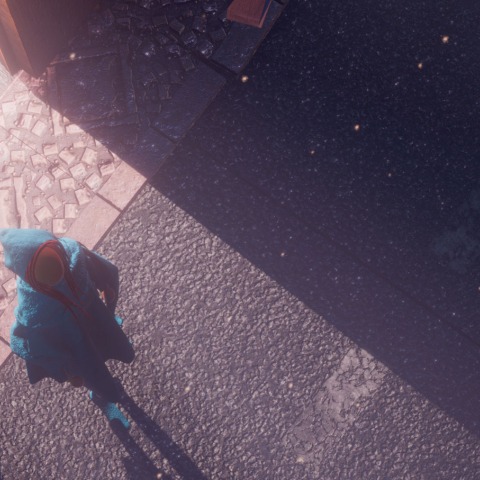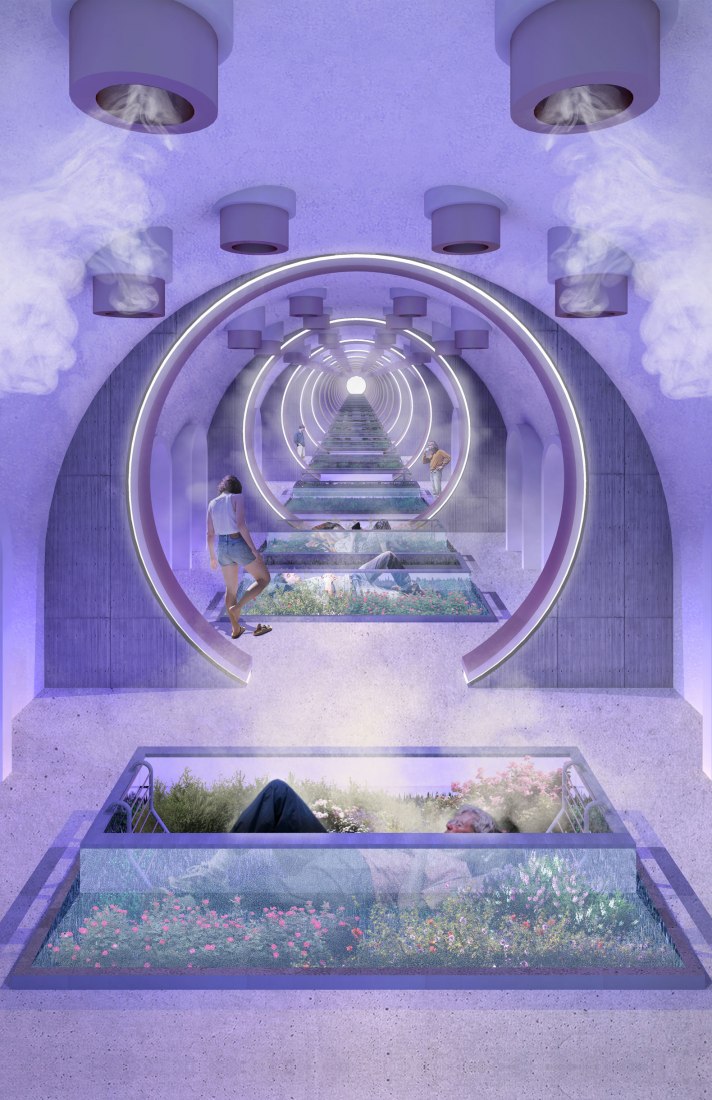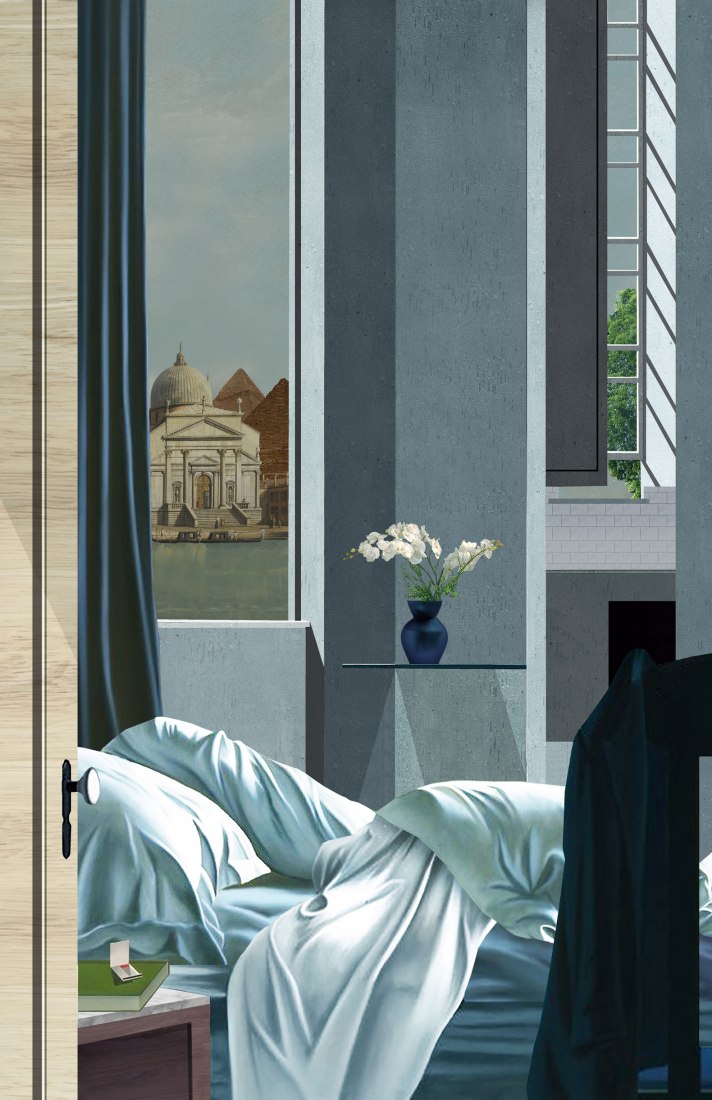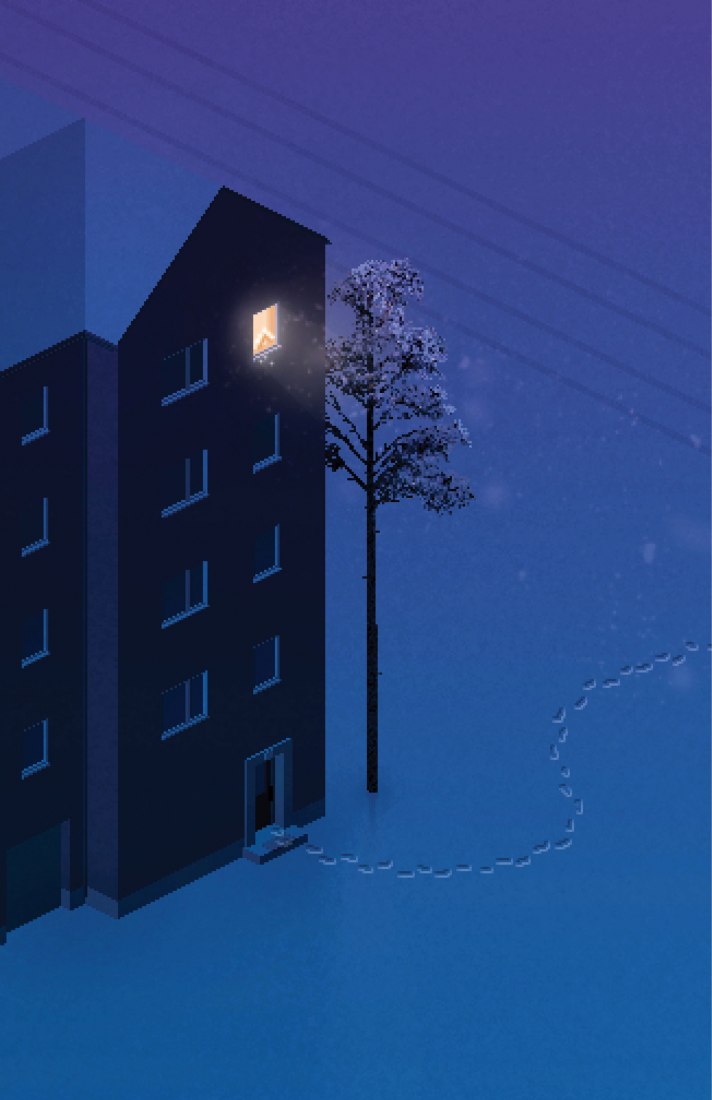The winners were chosen by a jury of more than 20 leading architects, designers and storytellers, including Moshe Safdie, Tatiana Bilbao, Jurgen Mayer, Julia Koerner, Mark Foster Gage and Jane Yolen, among many other distinguished judges. Francesca Giuliani, a co-founder of Blank Space, said:
"This year's winners utilize the power of narrative to explore complex issues like immigration, pollution, climate change, sea level rise, and the longevity of human impact. Time and time again, the Fairy Tales competition attracts creatives with a desire to inspire meaningful change in the world, through thought provoking and artistic submission that wrestle with the most urgent, real issues of our time".
Since its inception in 2013, the annual Fairy Tales challenge has attracted thousands of participants, and winners have gone on to develop their stories into successful Kickstarter campaigns, short films, comic books, and exhibitions.
This year’s jury selected three prize winners and 13 honorable mentions:
FIRST PLACE: "The Fall" by Lorena Cano Acosta and Nicolás Mendoza Ramos


Lorena and Nicolas are both Colombian architects, based in Bogotá. Nicolas has spent the last 2 years exploring the frontiers of architecture and storytelling in the entertainment industry, where he has worked as an environment artist on video game projects for both national and international companies. Lorena is also a designer passionate about emotional and critical design, with experience on editorial projects that deconstruct complex narratives into digestible, stunning visual pieces. They strongly believe that architecture should not be limited to shape buildings, but also used as a stage for ideas and concerns.
"The Fall was inspired by the mass exodus that people from Venezuela have been struggling for a while now, and how architecture and urbanism are not responding to this social problem. This is not an isolated issue- as it has been happening around the globe, boosting the belief that borders should be closed. We have normalized this matter and we have become more intolerant about the circumstances in which immigrants are subsisting. We have reached the point where we make invisible those who are in a different situation from ours. This tale portrays the story of a homeless woman who falls into a world that has forgotten its past and shows how media have misrepresented sensible subjects like environmental issues and migrations. The narrative challenges the reader to have a critical view of how our actions affect the world we are living in, reflecting human condition and evoking emotional impact".
Lorena Cano Acosta and Nicolás Mendoza Ramos
Extract
“I almost died for a plastic bottle,” she says, putting a cigarette to her lips.
I’ve got to ask. “A plastic bottle?”
“You heard me.” I strike a match for her as she talks, “it sounds strange because you can find plastic bottles anywhere, but it happened.”
“Was it a special bottle?”
“No, just a regular one. Like the one you are drinking water from right now.” She answers vaguely.
I could hardly picture it. Why would anyone face death for something as cheap as plastic? Is she making this up? This is not the first time I’ve shared a cigarette with her and she sounds sincere, even lucid. But how would I know? I don’t really know her. Even though I have seen her so many times walking down this street, we have never exchanged more than a couple of words.
She looks up at the wall for a while. I do the same. There’s a lot of waste built into it. Bottles, jars, cans, bags, tires… all turned into a massive structure: The Ecowall.
“Do you know why that keeps getting higher every year?” She says, still looking at it.
“Maybe it’s the quickest way to process all the rubbish we produce into something useful?”
She looks hard at me and for the first time I notice she is quite beautiful. Her hair is messy, her clothes are dirty, her shoes are ragged, and she looks pale and tired, but there is still something mesmerizing about her. The wind is salty and freezing at this hour and I wonder if she has a home, but don’t dare to ask. I offer her another cigarette and light one for myself.
“That’s one way to see it, I guess…” She says, after a long pause. “But let me show you a wider picture. You know how people are always talking about global warming, right?” I nod. “Well, we can’t leave that aside, but it isn’t the core of this story.”
I smile, so she continues. “Many years ago sea ice was melting and sea levels were rising very rapidly. Nobody really cared until life became unbearable with so many floods. Some rich governments started to come up with all kinds of solutions to deal with it, but nothing really worked. Eventually, they decided to literally wall-off the problem. They hired architects and construction firms to build barriers and walls, protecting people from the sea.
“With these solutions some countries achieved to separate earth from water. So it became easier to keep throwing out trash in the sea. For them, the once feared ‘Garbage Patch’ was not a problem anymore, in fact it was the best way to get rid of waste and keep clean cities.” She flicks her cigarette to remove the ash and keeps talking. “Shockingly these measures became obsolete promptly. As sea levels continued to rise, so did the wasteful water. Entire countries perished, after a thick layer of our bluish planet covered them completely. And the most vulnerable populations suffered the greatest losses. Countless souls were lost and some more became a weird, annoying and different human species: immigrants.”
She looks up one more time and releases a deep sigh. I look at her astonished. How does she know all this? Why would she bring this up now? Is this really all about that plastic bottle?
[...]
I’ve got to ask. “A plastic bottle?”
“You heard me.” I strike a match for her as she talks, “it sounds strange because you can find plastic bottles anywhere, but it happened.”
“Was it a special bottle?”
“No, just a regular one. Like the one you are drinking water from right now.” She answers vaguely.
I could hardly picture it. Why would anyone face death for something as cheap as plastic? Is she making this up? This is not the first time I’ve shared a cigarette with her and she sounds sincere, even lucid. But how would I know? I don’t really know her. Even though I have seen her so many times walking down this street, we have never exchanged more than a couple of words.
She looks up at the wall for a while. I do the same. There’s a lot of waste built into it. Bottles, jars, cans, bags, tires… all turned into a massive structure: The Ecowall.
“Do you know why that keeps getting higher every year?” She says, still looking at it.
“Maybe it’s the quickest way to process all the rubbish we produce into something useful?”
She looks hard at me and for the first time I notice she is quite beautiful. Her hair is messy, her clothes are dirty, her shoes are ragged, and she looks pale and tired, but there is still something mesmerizing about her. The wind is salty and freezing at this hour and I wonder if she has a home, but don’t dare to ask. I offer her another cigarette and light one for myself.
“That’s one way to see it, I guess…” She says, after a long pause. “But let me show you a wider picture. You know how people are always talking about global warming, right?” I nod. “Well, we can’t leave that aside, but it isn’t the core of this story.”
I smile, so she continues. “Many years ago sea ice was melting and sea levels were rising very rapidly. Nobody really cared until life became unbearable with so many floods. Some rich governments started to come up with all kinds of solutions to deal with it, but nothing really worked. Eventually, they decided to literally wall-off the problem. They hired architects and construction firms to build barriers and walls, protecting people from the sea.
“With these solutions some countries achieved to separate earth from water. So it became easier to keep throwing out trash in the sea. For them, the once feared ‘Garbage Patch’ was not a problem anymore, in fact it was the best way to get rid of waste and keep clean cities.” She flicks her cigarette to remove the ash and keeps talking. “Shockingly these measures became obsolete promptly. As sea levels continued to rise, so did the wasteful water. Entire countries perished, after a thick layer of our bluish planet covered them completely. And the most vulnerable populations suffered the greatest losses. Countless souls were lost and some more became a weird, annoying and different human species: immigrants.”
She looks up one more time and releases a deep sigh. I look at her astonished. How does she know all this? Why would she bring this up now? Is this really all about that plastic bottle?
[...]
SECOND PLACE: "Monuments of the Past" by Nick Stath

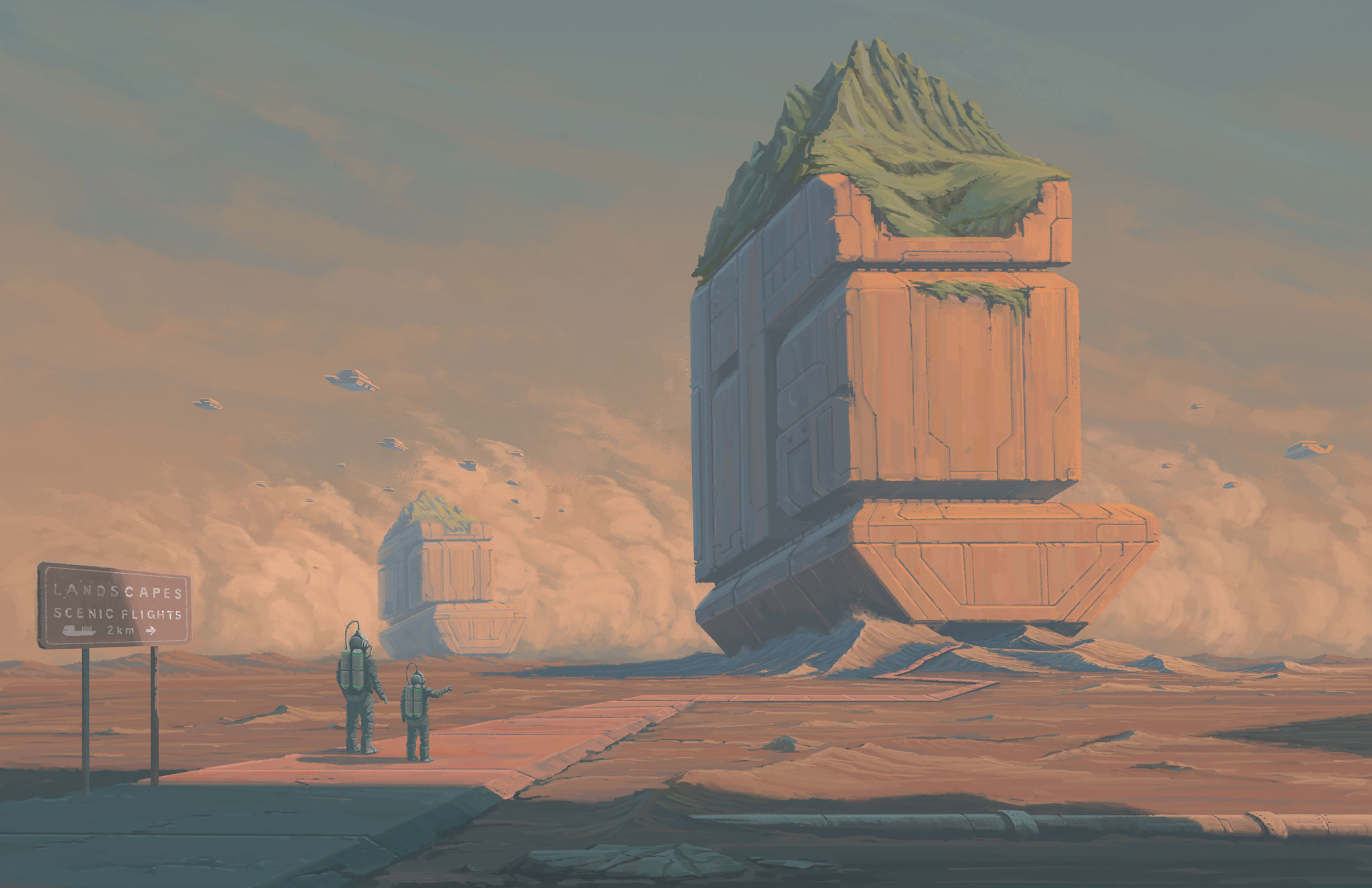
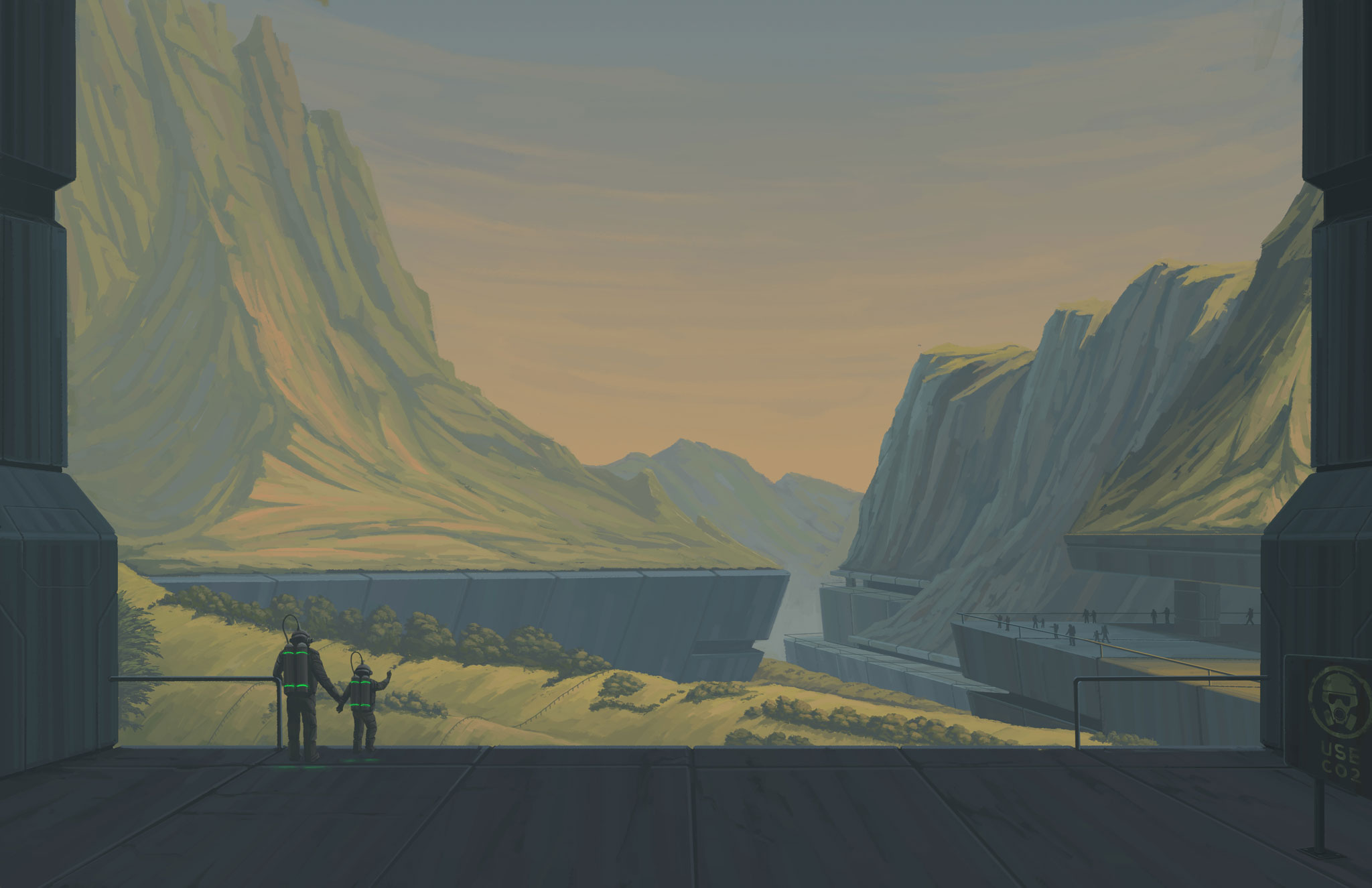

Nick is a concept artist, designer and illustrator based in Melbourne, Australia. Upon receiving his Masters in architecture from RMIT University, he has pursued working simultaneously as a designer in both Architectural Practice and the Entertainment Industry. His passion lies in creating visual stories of science-fiction that depict the relationship between the built and natural environment. His work is the continuous exploration of space, scale, composition and atmosphere, intending to evoke emotion that allows the viewers’ imagination to traverse.
"My story was inspired by climate change and how we currently take the beauty of our planet for granted. My desire was to represent this issue through a story that makes us wonder what life could be like in a future where mother nature and her resources have diminished before our eyes. A world where parents have to tell their children stories of what forests, mountains and grass fields where once like. My vision for this future environment was a series of over-scaled structures that hoist man made landscapes into the sky. These structures represent the monuments of our past".
Nick Stath
Extract
January 17th, 2119
Sunrise. 6.03am
I tell my son stories of what it was like to climb the mountains on Earth whilst we watched the sunrise over Monument 37. Forests have vanished. Mountains are covered in dust. The colour of nature a century ago, now non-existent. Reaching 100 years since the rapid decline of forests & all natural elements, Governments across the world came together to create an array of architectural megastructures to hoist man made landscapes into the sky. Thousands of people now flock from all over to experience what nature on earth was once like. Our children of this generation can only imagine what living earth was once like. For hundreds of years the human race took Mother Nature and her resources for granted. She was diminishing in front of our eyes. Hectares of forests gone, land cleared for cattle grazing, cities expanded and urbanization consumed the natural landscape. We ignored the initial signs of climate change and when we took it seriously it was already too late. The green began to diminish and the dust started to flow as earth slowly began to resemble the Martian landscape.
Early morning. 7.15am
We depart and descend down the cliff face. Suddenly, our feet begin to tremble and the red dust around us starts to move. A giant gust of wind hits us as courier V34 passes overhead, delivering what appears to be part of a manufactured forest, to a nearby Monument. These man made trees above us appear to tower into the sky, they remind me of the last few remaining redwoods that I was lucky enough to visit as a child. The nostalgia kicks in as we watch it pass by. The powerful, bunkeresque vessels are designed to carry hectares of landscapes at a time, whilst providing people with scenic flights to the artificial landscapes. The trees are delivered to specific monuments where the tradition of forest bathing or shinrin-yoku continues. Being in the presence of the trees back when Earth was flourishing and in particular, its forests, was said to impose an array of health benefits and overall well-being. As the inhabitants of earth, we can only dream of experiencing what the Japanese once spoke of as bridging the gap between us and the natural world. We are now confined to our oxygen supply and can only try and reclaim the memories of what it was like to breathe in the fresh air of the trees.
[...]
Sunrise. 6.03am
I tell my son stories of what it was like to climb the mountains on Earth whilst we watched the sunrise over Monument 37. Forests have vanished. Mountains are covered in dust. The colour of nature a century ago, now non-existent. Reaching 100 years since the rapid decline of forests & all natural elements, Governments across the world came together to create an array of architectural megastructures to hoist man made landscapes into the sky. Thousands of people now flock from all over to experience what nature on earth was once like. Our children of this generation can only imagine what living earth was once like. For hundreds of years the human race took Mother Nature and her resources for granted. She was diminishing in front of our eyes. Hectares of forests gone, land cleared for cattle grazing, cities expanded and urbanization consumed the natural landscape. We ignored the initial signs of climate change and when we took it seriously it was already too late. The green began to diminish and the dust started to flow as earth slowly began to resemble the Martian landscape.
Early morning. 7.15am
We depart and descend down the cliff face. Suddenly, our feet begin to tremble and the red dust around us starts to move. A giant gust of wind hits us as courier V34 passes overhead, delivering what appears to be part of a manufactured forest, to a nearby Monument. These man made trees above us appear to tower into the sky, they remind me of the last few remaining redwoods that I was lucky enough to visit as a child. The nostalgia kicks in as we watch it pass by. The powerful, bunkeresque vessels are designed to carry hectares of landscapes at a time, whilst providing people with scenic flights to the artificial landscapes. The trees are delivered to specific monuments where the tradition of forest bathing or shinrin-yoku continues. Being in the presence of the trees back when Earth was flourishing and in particular, its forests, was said to impose an array of health benefits and overall well-being. As the inhabitants of earth, we can only dream of experiencing what the Japanese once spoke of as bridging the gap between us and the natural world. We are now confined to our oxygen supply and can only try and reclaim the memories of what it was like to breathe in the fresh air of the trees.
[...]
THIRD PLACE: "Kaken in an 80 Million Gallon Tank" by Anthony D'Auria




Anthony is a designer of dubious repute from Portland, OR. He studied architecture at the University of Edinburgh and the Bartlett School of Architecture and he has worked throughout the US and in the UK on various projects that have, at times, become startlingly architectural. He is interested in the relationship between the stories people tell, the things people make and the way that the two often intertwine to reflect each other. He currently lives in Brooklyn, NY where he hopes to make it big someday.
"Kraken in an 80 Million Gallon Tank was written on a cell phone, on a commuter ferry shrouded in mist over a period of 4 work weeks. Beyond simply being an exercise in listing synonyms for fog, the tale imagines an uncanny future that is humid and sticky - a future where things have been set in motion and no matter how big we build or how intricately we plan, they cannot be undone. How do we make sense of such a future? How do we live on the tenuous ground that past decisions have engendered? In the end, it all seems pretty hazy".
Anthony D'Auria
Extract
It doesn’t really get that cold anymore, but back then, in the long dark of the North Sea winters, you could hear the older bladders--where the insulation had worn down or been scraped out by the bears--stretch and creak as the seawater inside them began to freeze. It’s been decades now since you’ve heard the keen that came with the retreat of the clouds and a stilling of the waves, but it still lingers fresh in your memory.
Tonight though, the clouds are thick and the air sweats with a saline humidity as you climb the tensile mast above South Settlement to see if you can make out the distant, blinking red light from Northport. The swirling brume, viscous and slow like white tar, obscures John’s signal but you linger for a moment to catch your breath and clean the condensation from your goggles. You glance a last time across the peculiar, bulbous landscape and take in the hulking mass of the bladders that hunch down towards the sea where the thick smell of salt is mixed with a tincture of methane seeping from the red algal blooms that have emerged this year with a startling fecundity. You yawn, knead the crick in your neck and make towards the ladder cage to head back down.
As you touch the first rung, you hear it. Muffled by the fog but distinct nonetheless, a ragged alien shriek saws across the night and sends a primal adrenal current lilting through your veins. The pitch, the timbre, you know it. You’ve heard it before but tonight, it is far too warm for the bladders to freeze.
You were born here on the platform and you left only twice. First, for two years to complete your studies at an dreary vocational college in Middlesbrough-On-The-Bay, where some days the tepid mist would roll in so thick off the North Sea that even the most experienced boatmen refused to plot a course through the low-lying cranes and smokestacks long rusted by the waves. The second time you left was for just three weeks to undergo a pulmonary procedure at a Newcastle clinic for an ailment that you still don’t entirely understand.
It was in your two years at Middlesbrough that you learned to steward the platform. They taught you how to patch the woven alumoskein textile by cutting away the sodden insulation around a leak and installing an isolation valve so that you could weld adjoining links together and seal the whole thing with a slurry of acrid bitumen. The sophisticated central control system had burnt out years ago, so you were taught to read the pressure on the bladders with a triangulating radio and how to manually adjust the draw of the pumps to raise and lower the water pressure. It’s demanding and meticulous work but there is a peculiar tidal cadence to it that keeps the tedium at bay. You’ve become so attuned to the rhythmic equilibrium of the platform that any imbalances leave you feeling dissonant and ill at ease.
[...]
Tonight though, the clouds are thick and the air sweats with a saline humidity as you climb the tensile mast above South Settlement to see if you can make out the distant, blinking red light from Northport. The swirling brume, viscous and slow like white tar, obscures John’s signal but you linger for a moment to catch your breath and clean the condensation from your goggles. You glance a last time across the peculiar, bulbous landscape and take in the hulking mass of the bladders that hunch down towards the sea where the thick smell of salt is mixed with a tincture of methane seeping from the red algal blooms that have emerged this year with a startling fecundity. You yawn, knead the crick in your neck and make towards the ladder cage to head back down.
As you touch the first rung, you hear it. Muffled by the fog but distinct nonetheless, a ragged alien shriek saws across the night and sends a primal adrenal current lilting through your veins. The pitch, the timbre, you know it. You’ve heard it before but tonight, it is far too warm for the bladders to freeze.
You were born here on the platform and you left only twice. First, for two years to complete your studies at an dreary vocational college in Middlesbrough-On-The-Bay, where some days the tepid mist would roll in so thick off the North Sea that even the most experienced boatmen refused to plot a course through the low-lying cranes and smokestacks long rusted by the waves. The second time you left was for just three weeks to undergo a pulmonary procedure at a Newcastle clinic for an ailment that you still don’t entirely understand.
It was in your two years at Middlesbrough that you learned to steward the platform. They taught you how to patch the woven alumoskein textile by cutting away the sodden insulation around a leak and installing an isolation valve so that you could weld adjoining links together and seal the whole thing with a slurry of acrid bitumen. The sophisticated central control system had burnt out years ago, so you were taught to read the pressure on the bladders with a triangulating radio and how to manually adjust the draw of the pumps to raise and lower the water pressure. It’s demanding and meticulous work but there is a peculiar tidal cadence to it that keeps the tedium at bay. You’ve become so attuned to the rhythmic equilibrium of the platform that any imbalances leave you feeling dissonant and ill at ease.
[...]
The Jury awarded 9 honorable mentions to: Constantinos Marcou; Carl Ydergård; Xiaoyin Xie; Jono Bentley Sturt; Michael Leckie, Ryan Nelson and Jason Hall; Anna Kuchera; Albert Orozco; Bojana Papic and Yann Junod; Ahad Almeida Sheikh; Erik Bean; Haley Koesters, Natalia O'Neill Vega and Daria Piekos; Sungmin Kim, Junghun Park and Hoyoung Roh; and Claudia Wainer. They can be seen in the image gallery below.
Winning stories and honorable mentions can be read in their entirety, click here.
2019 Jury.-
Moshe Safdie (Safdie Architects)- Tatiana Bilbao (Tatiana Bilbao)- Jurgen Mayer (J. MAYER H)- Mark Foster Gage (Mark Foster Gage Architects)- Jane Yolen (Author)- Stuart Wood (Heatherwick Studio)- Vanessa Keith (StudioTEKA)- Sebastian Behmann (Olafur Eliasson)- Claire Weisz (WXY)- Jennifer Newsom (Dream the Combine)- Thomas Carruthers (Dream the Combine)- Julia Koerner (JK Design GmbH)- Gabriela Etchegary (AMBROSI | ETCHEGARAY)- Alan Maskin (Olson Kundig)- Louis Liu (Fairy Tales 2018 Winner)- Senyao Wei (Fairy Tales 2018 Winner)- Alexander Walter (Archinect & Bustler)- Becky Quintal (ArchDaily)- David Basulto (ArchDaily)- Amy Rosen (AIAS)- Brigid Callaghan (AIAS)- Matthew Hoffman (Blank Space)- Francesca Giuliani (Blank Space)- Anna Creatura (Blank Space).
